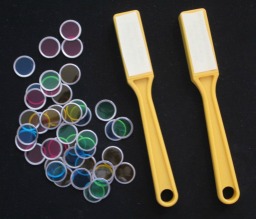- Home
- Teaching Strategies
- Schedules of Reinforcement
Schedules of Reinforcement: Changing Behavior Using Rewards
 Chipper chips are fun reinforcers for kids.
Chipper chips are fun reinforcers for kids.Schedules of reinforcement, special systems of rewarding behavior, can help make your goals for training good behavior in your child a reality. I’ll show you how this process can work.
For example, suppose you want your child to learn to take her shoes off when she comes into the house.
Most of the time, you may be able to get kids to do this just by telling them each time and hoping they'll establish a habit. And it often works well this way.
But there may be times that you just can't seem to get her to do what you want her to do. Some of our kids need a bit of extra help.
Schedules of reinforcement or operant conditioning can provide this help.
With this approach, you're rewarding your child according to a schedule and then fading out the rewards.
Continuous Schedule
With continuous reinforcement you are rewarding her every time she does what you want her to do.
Let’s go back to our example of the shoes.
The first step I would take is to instruct her to take her shoes off. If she does this, I give her a small reward along with lots of praise.
I may have to keep telling her to take her shoes off, and fade this verbal prompt as soon as I can. But each time she takes them off, I give her a reward.
Once you think she is successfully doing this task with rewards, it’s time to start getting her less dependent on reinforcers.
But if you discontinue the rewards at this point, she might stop this good behavior altogether. You don’t want that to happen.
Instead, you can switch to fixed schedules.

Fixed Schedules
With a fixed schedule of reinforcement you are now rewarding her every fixed number of times that she takes her shoes off at the door. And you decide whether it will be every two, three or four times.
Once you see that she is successfully performing the behavior on a fixed schedule, you will want to switch to variable schedules of reinforcement.
Variable Schedules of Reinforcement
On this schedule you’ll vary the number of times she has to take her shoes off before she gets a reward. This is an important step in this process because it’s very difficult to unlearn a behavior on a variable schedule.
Gambling is a good example of a behavior that’s difficult to extinguish or erase because it’s reinforced on a variable schedule. Gamblers can see that once in a while someone wins big. So they never know if they’ll be the next winner. And they also may win a bit of money once in a while.
In a similar way, a learner on a variable schedule never knows when her behavior will earn the reward. So she keeps trying, thinking this time she may get the reward.
Once she is used to getting a reward only once in a while, it would be fairly natural to fade out the rewards.
Praise Her for Her Efforts

Whether or not you need to use schedules of reinforcement, I highly recommend giving your child lots of praise when she has done well and even for trying. Praise gives her a boost of confidence, and it lets her know exactly what she has done so well and why she is being rewarded.
It's absolutely essential for success.
I also recommend fading from other rewards to praise only. Then you can fade out most of the praise as you see fit.
You may also choose to do as I do and skip the fixed schedule entirely. It depends on what your child needs. But I usually progress from a continuous schedule to a variable schedule with no problem.
Remember that you may not need schedules of reinforcement to teach every skill to your child, but they can be very effective when he needs more than simple reminders.
Please see my page on rewards for more information on choosing effective reinforcers.



New! Comments
Have your say about what you just read! Leave me a comment in the box below.